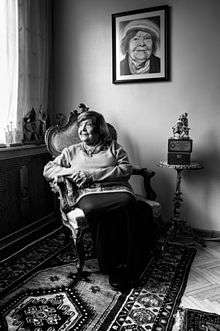Muazzez İlmiye Çığ
| Muazzez İlmiye Çığ | |
|---|---|
 | |
| Born |
Muazzez İlmiye İtil 20 June 1914 Bursa Province, Ottoman Empire |
| Nationality | Turkish |
| Education | Archaeology, Hittitology, Sumerology |
| Alma mater | Ankara University |
| Occupation | Archaeologist, Sumerologist, Assyriologist, writer |
Muazzez İlmiye Çığ, née Muazzez İlmiye İtil, (born 20 June 1914, Bursa Province, Turkey) is a Turkish archaeologist and Assyriologist who specializes in the study of Sumerian civilization. In 2006, at the age of 92, she received world-wide coverage in international media outlets when, upon publication of her 2005 book which described, among other topics, how her research into the history of the headscarf revealed that it did not originate in the Muslim world, but was worn five thousand years ago by Sumerian priestesses who initiated young men into sex.
Early life
Muazzez İlmiye İtil's parents were Crimean Tatars both of whose families had immigrated to Turkey, with her father's side settling in the town of Merzifon, and her mother's side in the northwestern city of Bursa, Turkey's fourth-largest, which was, at the time, a major regional administrative center of the Ottoman Empire. Muazzez Ilmiye was born in Bursa, a few weeks before the outbreak of World War I and, by the time of her fifth birthday in 1919, the Greek Army's invasion of İzmir prompted her father, who was a teacher, to seek safety for the family by moving to the city of Çorum where young Muazzez completed her primary studies. She subsequently returned to Bursa and, by the time of her 17th birthday in 1931, graduated from its training facility for elementary school teachers.
Educational credentials
After nearly five years of educating children in another northwestern city, Eskişehir, she began studies in 1936 at Ankara University's Department of Hittitology, established the previous year by modern Turkey's founding father, Mustafa Kemal Atatürk. Among her teachers were two of the period's most eminent scholars of Hittite culture and history, Hans Gustav Güterbock and Benno Landsberger, both Hitler-era German-Jewish refugees, who spent World War II as professors in Turkey.[1]
Upon receiving her degree in 1940, she began a multi-decade career at Museum of the Ancient Orient, one of three such institutions comprising Istanbul Archaeology Museums, as a resident specialist in the field of cuneiform tablets, thousands of which were being stored untranslated and unclassified in the facility's archives. In the intervening years, due to her efforts in the deciphering and publication of the tablets, the Museum became a Middle Eastern languages learning center attended by ancient history researchers from every part of the world.[1]
Professional career and court case
Married to M. Kemal Çığ, the director of Topkapı Museum, Muazzez İlmiye Çığ is also a prominent advocate for secularism and women's rights in Turkey, and an honorary member of German Archeology Institute and İstanbul University Institute of Prehistoric Sciences. She has gained renown in her profession for the diligent and systematic investigation evident in her books, scholarly papers and general interest articles published in magazines and newspapers such as Belleten and Bilim ve Ütopya. In 2002, her autobiography, Çivi çiviyi söker, framed as a series of interviews by journalist Serhat Öztürk was published by the country's premier national financial institution Türkiye İş Bankası.
She and her publisher were charged with "inciting hatred based on religious differences".[2] The dismissal of the charges in the first hearing on 31 October 2006, and her acquittal brought additional publicity to Prof. Çığ.[3][4] In her trial, she denied the charges, declaring "I am a woman of science ... I never insulted anyone".[5][6] At that initial trial hearing, the judge dismissed her case and, following a trial less than half hour in duration, the book's publisher was acquitted.[7][8][9]
Partial bibliography
- 1993: Zaman Tüneli ile Sümer'e Yolculuk [Journey to Sumer through a Time Tunnel" (written as children's educational literature)
- 1995: Kur'an, İncil ve Tevrat'ın Sümer'deki Kökeni [The Origins of the Koran, the Bible and the Torah in Sumer]
- 1996: Sümerli Ludingirra [Ludingirra the Sumerian, a retrospective science-fiction] (İbrahim Peygamber)
- 1997: The Prophet Abram, According to Sumerian Writings and Archeological Findings
- 1998: İnanna'nın Aşkı [The Love of Inanna, the Belief and the Holy Marriage in Sumer]
- 2000: Hititler ve Hattuşa [The Hittites and Hattuša, as Written by Ishtar] (Ortadoğu Uygarlık Mirası)
- 2002: Civilization Heritage in the Middle East
- 2005: Bereket Kültü ve Mabet Fahişeliği [Cult of Fertility and Holy Prostitution]
- Works include numerous translations from English.
References
- 1 2 "Muazzez Çığ stands among the world’s best Sumerologists" (Hürriyet Daily News, 14 November 2008)
- ↑ "All eyes turn to observe trial of Sumerian expert in Turkey" (Hürriyet Daily News, 26 October 2006)
- ↑ "92 year old Sumerian specialist aquitted [sic] in first hearing" (Hürriyet Daily News, 31 October 2006)
- ↑ "Turkey court clears archaeologist". (BBC News, 1 November 2006)
- ↑ "Historian Cig aquitted [sic], meets with loud support outside courtroom" (Hürriyet Daily News, 2 November 2006)
- ↑ Fraser, Suzan (2006). "Author, 92, Cleared of Islam Insult". (The Standard, 2 November 2006)
- ↑ Muazzez Ilmiye Cig at Indonesia Matters website (includes reprint of article on the case from The Australian and 48 comments/disputes posted between 1 November 2006 and 22 May 2009)
- ↑ Arsu, Sebnem. "Turkish scholar, 92, is acquitted in head scarf case". International Herald Tribune (1 November 2006)
- ↑ Arsu, Sebnem. "Turkish Scholar Who Mocked Head Scarves Is Acquitted". The New York Times (2 November 2006) (includes photograph of Muazzez İlmiye Çığ outside courtroom following the acquittal)